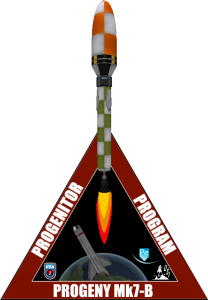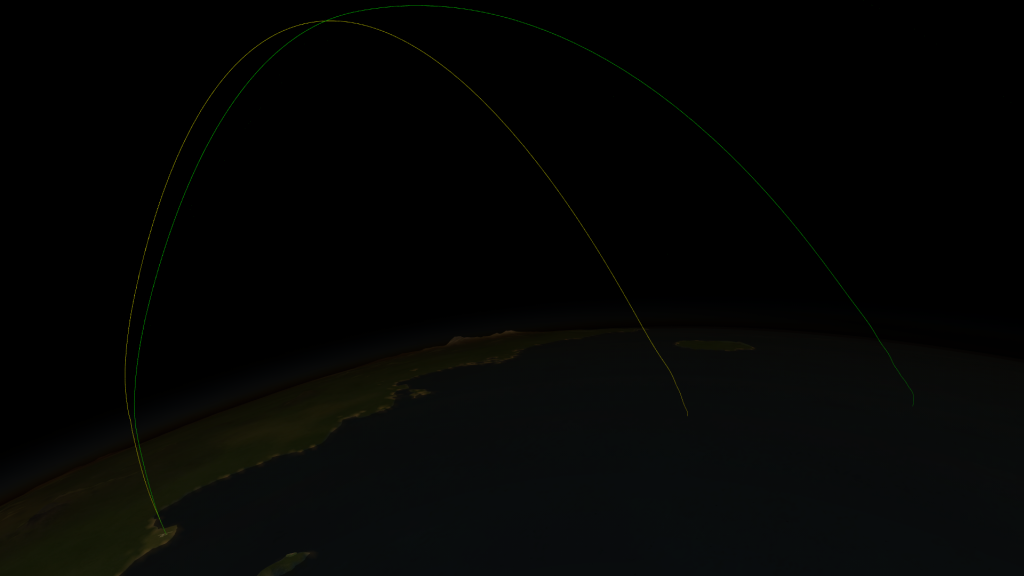 A pause after the first two launches was required to not only build the final two rockets but also to launch the second Ascension Mk2, which required a pad reconfiguration. The pad was setup again afterwards to support Mk7-B launches and the third rocket was trucked out to the pad to perform its mission, which we hoped would finally see the rocket on a high sub-orbital trajectory with a successful hot staging to avoid losing speed on ascent. While the launch date did not change, the rocket’s new 0.625m SRB was swapped out for a refurbished SRB to test under flight conditions for the first time after making it through two static fires.
A pause after the first two launches was required to not only build the final two rockets but also to launch the second Ascension Mk2, which required a pad reconfiguration. The pad was setup again afterwards to support Mk7-B launches and the third rocket was trucked out to the pad to perform its mission, which we hoped would finally see the rocket on a high sub-orbital trajectory with a successful hot staging to avoid losing speed on ascent. While the launch date did not change, the rocket’s new 0.625m SRB was swapped out for a refurbished SRB to test under flight conditions for the first time after making it through two static fires.
The Flight
No delays occurred during pre-launch preparations and everything was looking good for an on-time lift off when a hold was called from the weather desk just 8 seconds prior to T-0. The mountain wave sensors were tripped and due to the high instability of the rocket without its support arms a hold had to be called before they were retracted at T-5s. No gusts were recorded at KSC in the following minutes however and after some more checking on the weather data it was determined to be a false alarm and the countdown was reset to T-2min with a new launch time of 18:00 local. The hold was released 29 minutes after it was called. T-0 arrived without further incident, all four support arms retracted properly and the Boostertron II first stage was successfully ignited to begin the ascent.
The rocket left the pad with an initial force of 3Gs as the SRB produced a maximum of 74kN of thrust. After just 6 seconds the thrust beginning to gradually taper off and keep loads on the rocket reasonable. Guidance had been active since immediately after launch to use the fins to pitch the rocket over, already facing direct east along its direction of travel as planned. The rocket passed through Max Q at L+21s with 51.782kPa @ 4.577km and the booster nearly halfway through its fuel. A few seconds later the rocket was passing Mach 1.3 and fin flutter became noticeable, shaking the rocket rather violently.
The instability lasted all the way up to staging at L+46s, when the booster ran out of fuel at 16.911km. The interstage fairing was blown apart into two pieces to ensure the upper-stage Ospray engine would not impact it and then less than a second later the lower stage was pushed away by the activation of the Ospray at full thrust of 13kN. Despite our hope that the cleaner and faster stage separation would help the upper stage maintain attitude, it went into a tumble just 3 seconds after starting its burn.
Onboard guidance managed to recover the rocket as it passed through 22km but because the engine’s thrust vector control was its only means to do so it could not be shut off and thus precious fuel and airspeed was lost from the tumble. This caused the flight computer to shut down the engine prematurely at L+1m34s, 41.7km with an apokee of 80km, so there possibly remained enough fuel that we could attempt to restart the engine in space. The air at this height was still enough to drag the nose around and put the rocket back into a tumble as it continued to climb up out of the atmosphere. During powered ascent it reached a speed of only just over 1km/s.
Exiting the atmosphere at L+2m24s the Stability Assist System was activated shortly afterward to bring the reaction wheels online and halt the rocket’s tumble so it could point prograde for an engine restart. Although fuel levels were at their lowest of all three missions so far and controllers were also seeing low tank pressure, when the command was sent up at L+3m7s we got confirmation of good thrust from the Ospray, now in vacuum outputting its maximum rate of 13.5kN. The burn only lasted just over 8s and did not have any major affect on the rocket’s trajectory but was a good test of the engine’s ability to restart under less than optimal conditions.
A few seconds later at L+3m18s the rocket passed through an apokee of 79.604km to begin its fall back towards Kerbin. Controllers commanded it to use the SAS and re-orient retrograde so that the engine was facing downwards and would take the brunt of heating on re-entry. The flight computer was purged of ascent instructions and commands for re-entry were loaded so it would properly deploy its air brakes and parachute. The rocket had completely flipped around with 19s to spare before it breached the atmosphere at L+4m13s and SAS was switched off.
Re-entry appeared to go normally. Plasma blackout occurred just over a minute in at L+5m15s and lasted for 38s before the link was restored as the thicker air of the lower atmosphere slowed the rocket down from a peak velocity of 1.122km/s. Dynamic pressure and G-force continued to build however, peaking just 2-6 seconds later with a Max Q of 122.157kPa at 9.248km and a force of 13.3Gs, respectively. We got report of air brake deployment and shortly afterward at L+5m53s we had confirmation the parachute had deployed in its reefed state.
Although the rocket had by now dropped below the horizon from KSC and was also not able to be seen by Sheltered Rock’s aerial tower, the launch delay had brought Kerbin II overhead during the flight. Our recovery vessel MSV Aldeny was still able to receive rocket telemetry and relay it to us through Kerbin II, allowing us to watch as the chutes fully deployed at L+6m15s before it fell below the horizon from the Aldeny’s view. Although there was much celebration in mission control having finally succeeded at achieving all mission goals, the unfortunate news came in a few hours later when the Aldeny reached the rocket 145.728km downrange – everything below the flight computer had been ripped away and we could still not complete one of the primary mission goals in recovering the engine for a detailed post-flight analysis of how the gimbal control system held up.
Flight Analysis
Ascent Tumble
This was only the second attempt to hot-stage the rocket after the last mission, which also resulted in a tumble. The rocket was released in a better position, with a smaller angle of attack and held orientation slightly longer but in the end was still unable to use its thrust vector control to maintain proper attitude. In both ascents the rocket was able to recover itself after passing through 22km ASL and during this flight the recovery was also faster as the initial tumble was not as violent. So there was definite improvement, but not as much as we’d hoped for.
Ultimately the large nose just produced too much drag for the TVC system to overcome.
In-Flight Engine Restart
This was certainly a highlight of the mission given how low fuel levels were after the rocket reached 80km apokee and cut off thrust. 29kg of fuel was all that remained, by far the lowest amount of all three flights – flight 1 had 47kg remaining while flight 2 was left with 40kg. The tanks are pressurized before flight so if fuel levels fall this low the amount of gas inside to keep the fuel pushed to the bottom isn’t supposed to be enough to force it into the engine on restart. We could be wrong about the amount of pressure needed, but if we are right and the engine shouldn’t have restarted the other explanation could be the tumble the rocket was left in as it exited the atmosphere. This could have been enough force to keep the fuel settled on the bottom of the tank.
Re-Entry Breakup
The best we can determine about the re-entry was the velocity became too great. Past data from Progeny Mk6 re-entry breakups corroborates this as several of those rockets came apart under similar circumstances. It does highlight how fickle re-entry can be. The second Mk7-B mission returned on a steeper angle but was only able to reach a maximum velocity of 1.01km/s – only 122m/s slower than this return. That saw the rocket undergo max stress of 84.745kPa while enduring a peak of only 6.2Gs. The steeper return could have also imparted less lateral force on the rocket during the high-stress moments, but this is still not a well-understood flight regime.
Future Plans
The hold at launch was a proper precaution to take despite the false alarm. The phenomenon of mountain waves is still not well understood but Lead Scientist Cheranne has some researchers working on it in cooperation with the Kerbin Weather Service so in the future the warning system will generate fewer false positives.
While we were disappointed that the rocket failed to completely survive re-entry the fact that we were still able to recover the flight computer and all the flight data will only help us to understand how to better plan return trajectories and ultimately make future missions even safer and more successful.
Although the final Mk4 mission has already flown, enough data analysis was conducted from this mission to show that returning to 25km coast like the first mission was still the best option for a clean ascent. Despite the recoveries after 22km we felt that 25km remained a better error margin to ensure attitude stability.








